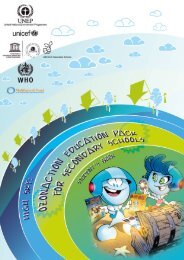Chapter 2. Progress towards the EFA goals - Unesco
Chapter 2. Progress towards the EFA goals - Unesco
Chapter 2. Progress towards the EFA goals - Unesco
You also want an ePaper? Increase the reach of your titles
YUMPU automatically turns print PDFs into web optimized ePapers that Google loves.
PROGRESS TOWARDS THE <strong>EFA</strong> GOALS<br />
Early childhood care and education<br />
poor guide to deprivation. Guatemala is not one<br />
of <strong>the</strong> world’s poorest countries, but it has one<br />
of <strong>the</strong> highest levels of child stunting. Almost half<br />
of <strong>the</strong> country’s children are malnourished – and<br />
in parts of rural Guatemala, where <strong>the</strong> population<br />
is largely Mayan, <strong>the</strong> figure reaches 80%. Over<br />
<strong>the</strong> past two years, drought and high food prices<br />
have made things worse. But <strong>the</strong> underlying<br />
problem is extreme inequality in wealth<br />
distribution, allied to <strong>the</strong> failure of government<br />
to mobilize resources for social protection.<br />
Nutritional indicators have been deteriorating<br />
in many countries over <strong>the</strong> past two years.<br />
World agricultural prices rose sharply in <strong>the</strong><br />
two years to 2008, affecting all major traded<br />
food staples. While prices have since fallen, <strong>the</strong>y<br />
have stabilized at levels far higher than <strong>the</strong>y were<br />
before 2007. Effects at <strong>the</strong> national level have<br />
varied considerably, depending on <strong>the</strong> incidence<br />
of poverty and dependence on food imports.<br />
However, higher food prices have almost certainly<br />
stalled global progress in cutting malnutrition.<br />
Recent estimates from <strong>the</strong> Food and Agricultural<br />
Organization of <strong>the</strong> United Nations suggest that<br />
<strong>the</strong> number of malnourished people in <strong>the</strong> world<br />
increased from 848 million in 2005 to 963 million<br />
in 2008, largely because of rising food prices<br />
(FAO, 2008). Ano<strong>the</strong>r 44 million people may<br />
have been pushed into malnutrition during 2008<br />
(Commission on Growth and Development, 2008).<br />
The damage inflicted by higher food prices has<br />
been unevenly spread. Outcomes depend on<br />
whe<strong>the</strong>r households are net sellers or buyers<br />
of food, on access to savings or credit and on<br />
current nutritional status. For people living below<br />
<strong>the</strong> international poverty threshold of $1.25 a day,<br />
many of whom spend 50% to 70% of <strong>the</strong>ir income<br />
on food, higher food prices pose a stark choice:<br />
eat less or decrease spending in o<strong>the</strong>r areas<br />
(von Braun, 2008; World Bank, 2008a). Landless<br />
rural households, low-income urban groups and<br />
female-headed households have been among<br />
<strong>the</strong> hardest hit. Many have cut already inadequate<br />
diets and switched from protein-rich foods to<br />
cheaper coarse cereals (Hauenstein Swan et al.,<br />
2009; von Braun, 2008). In Bangladesh, where<br />
rice and wheat prices almost doubled in 2007,<br />
it is estimated that a 50% increase in <strong>the</strong> price<br />
of food staples increases <strong>the</strong> prevalence of iron<br />
deficiency among women and children by 25%<br />
(Bouis, 2008).<br />
Figure <strong>2.</strong>2: Low birth weight sets <strong>the</strong> scene for lifelong disadvantage<br />
Average % of infants with low birth weight, selected regions, 2000–2007 1<br />
% of infants with low birth weight<br />
30<br />
25<br />
20<br />
15<br />
10<br />
5<br />
0<br />
East Asia/<br />
Pacific<br />
Latin America/<br />
Caribbean<br />
Middle East/<br />
North Africa<br />
Sub-Saharan<br />
Africa<br />
Notes: Regions presented are those used by UNICEF, which differ to some extent from<br />
<strong>the</strong> <strong>EFA</strong> regions. Low birth weight is defined as less than <strong>2.</strong>5 kilograms.<br />
1. Data are for <strong>the</strong> most recent year available during <strong>the</strong> period specified.<br />
Source: UNICEF (2008b).<br />
Short-term distress in <strong>the</strong> form of rising malnutrition<br />
will have long-term consequences for education.<br />
As more children experience episodes of<br />
malnutrition in early childhood <strong>the</strong>ir prospects for<br />
learning will be diminished. At <strong>the</strong> same time, rising<br />
pressure on household budgets will have wider<br />
consequences as poor parents are forced to adjust<br />
household budgets. There is evidence from<br />
Bangladesh, Jamaica and Kenya of households<br />
cutting education spending to accommodate higher<br />
food prices (Hossain et al., 2009; World Bank, 2008e).<br />
High food prices have not been <strong>the</strong> only cause<br />
of rising malnutrition. In nor<strong>the</strong>rn Sri Lanka,<br />
300,000 people were displaced by conflict in 2009.<br />
It is estimated that about 13% of <strong>the</strong> displaced<br />
were children under 5. A survey covering six of<br />
<strong>the</strong> thirteen camps for displaced people found<br />
that one in four children was malnourished and<br />
one in three was moderately or severely stunted<br />
(Jayatissa, 2009). Failure to adequately protect<br />
<strong>the</strong>se children raises wider issues of humanitarian<br />
concern. But <strong>the</strong> consequences for education will<br />
also be severe.<br />
South<br />
Asia<br />
Maternal health — critical, but neglected<br />
The health of newborn children – critical for later<br />
educational chances – is intimately related to<br />
<strong>the</strong> health of <strong>the</strong>ir mo<strong>the</strong>rs. Women who are<br />
malnourished and suffering from micronutrient<br />
deficiency face far higher risks during pregnancy<br />
and childbirth, and are more likely to give birth to<br />
underweight babies. Restricted growth of <strong>the</strong> foetus<br />
during pregnancy is a major risk factor for maternal<br />
health and child survival – and is likely to lead to<br />
future educational disadvantage.<br />
Short-term<br />
distress in <strong>the</strong><br />
form of rising<br />
malnutrition will<br />
have long-term<br />
consequences<br />
for education<br />
45
















